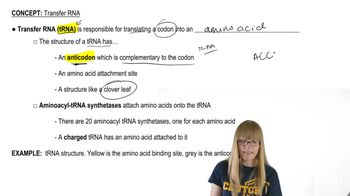Here are the essential concepts you must grasp in order to answer the question correctly.
Nucleic Acids
Nucleic acids, such as DNA and RNA, are biopolymers essential for all known forms of life. They are composed of nucleotide monomers, which include a sugar, a phosphate group, and a nitrogenous base. The sequence of these bases encodes genetic information, guiding the synthesis of proteins and regulating cellular functions.
Recommended video:
Base Composition
Base composition refers to the relative amounts of the four nitrogenous bases in a nucleic acid molecule. In DNA, these bases are adenine (A), thymine (T), cytosine (C), and guanine (G), while RNA contains uracil (U) instead of thymine. Analyzing base composition can provide insights into the structure and function of the nucleic acid, as well as its evolutionary relationships.
Recommended video:
Non-Canonical Bases
Non-canonical bases, such as xanthine and hypoxanthine, are nitrogenous bases that are not typically found in standard DNA or RNA. Their presence can indicate unique metabolic pathways or adaptations in certain organisms. Understanding these bases is crucial for studying the genetic material of primitive eukaryotes and their evolutionary significance.
Recommended video:





